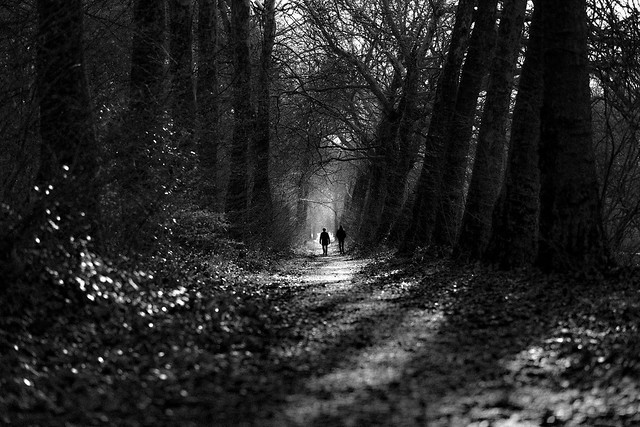|

At the heart of the late Thomas Merton’s works is contemplation, or pure prayer. Merton wrote, in New Seeds of Contemplation, that contemplation is “the union of the simple light of God with the simple light of our spirit, in love.”
* * *
In 1940 Merton had an experience that was formative for his teaching and experience of contemplation and which he wrote of in Seven Storey Mountain. During a visit to Cuba, while attending Sunday Mass in Havana, he heard children at the front of the church cry out the creed in glad unison. Merton was struck with a sudden awareness of the Divine Presence. He later wrote, “It was a light that was so bright that it had no relation to any visible light and so profound and so intimate that it seemed like a neutralization of every lesser experience.” His first clear thought was, “Heaven is right here in front of me: Heaven, Heaven!”
Still, Merton was clear that this light was ordinary and available to every Christian. He taught contemplation is for all Christians, not for a certain disposition of persons or a spiritual elite. Each Christian can become “fused into one spirit with Christ in the furnace of contemplation” and benefit other persons with the fruit of his or her spirituality.
Merton came to discern this same Light and contemplation in other faith paths, especially through his interest in Buddhism. Contemplation drew Merton outside the bounds of his inherited teachings into Truth, where he found the Word before all truths, where he witnessed the Silence lives.
As with Merton hearing the glad unison of the children, we never know what ordinary happening will awaken our being with Grace. This Grace draws us back into the Silence, a Silence not just within, but without and everywhere. This Silence unites the form and the formless in one experience.
This crying out of the creed reminds of the Buddha teaching, "Emptiness is form, Form is emptiness." The speaking forth of the creed is form, and Merton is touched by what is within the form, the depths from which the joyful unison arises into form. The children, the joy, the creed, the church, the glad unison, Merton, ... the entire context arises from these depths. The depths sacralize all things.
* * *
Contemplation introduces us to this inner terrain, a terrain where subtle realms are constantly in motion. Yet, within this fluidity, contemplation initiates us to the Mystery on which even this subtleness rests, eternally. Buddhism and Christianity have ways of speaking of this unspeakable Ground. Meister Eckhart spoke of this as the Godhead before even the Trinity, or Father, Son, Holy Spirit. Buddhism speaks of the most subtle kaya, or Buddha body, as Dharmakaya, meaning "Truth Body, or Body of Truth." Eckhart and Buddhism agree this Ground of Being is prior to existence and nonexistence.
Regardless of the depths and the Source, and how different systems speak of it, as embodied beings we are often awakened to contemplation, or the formless Silence, by form. This may not be seen to be sacred, or holy, but quite ordinary. Silence awakens us to itself, for even the gladsome voicing of the creed, from the mouths of children, rests on the graciousness of Silence. Through those joyful voices, one is embraced by Grace and adores Grace in return.
* * *
The falling of a drop of rain from a leaf is a potential form for awakening to Life, and so is religious ritual. And we may be more receptive to see Grace in some ways than others, based on our prior conditioning, or our movement away from prior conditioning. Yet, becoming intimate with the Silence, we become more receptive to the different ways Grace appears, as we are drawn from our prejudices into that within the embrace of Grace. Our preferences no longer blind us to the Light shining through a wide array of forms, some quite surprising to us. We may, indeed, find our prejudices challenged by this Light appearing outside where we discern it ought to or can appear.
* * *
Someone in a worship gathering mentioned children participating in an Easter ritual. Some in the group appeared to find this laughable, as one can tell a laugh of celebration from a laugh of derision. I found this odd, that persons who claimed to be inclusive excluded the possibility of Grace manifesting through such simple childlike ritual ~ possibly, those who laughed do not believe in Grace, or do not believe in ritual. I discerned immediately how wonderful this would be, to see children joyfully participating in an Easter celebration, even as I had done as a child. The Sacred shows up where and how the Sacred shows up, the question is, "Am I ready to see that?" If prepared to see, for we are seeing daily, we are sensitized to the way Silence manifests the Light, even in contexts that we do not anticipate the Holy to alert us to its presence. Why? The depths, and that before, is already everywhere.
* * *
With praises from children
and from tiny infants,
you have built a fortress.
It makes your enemies silent,
and all who turn against you
are left speechless.
*Hebrew Bible. Psalm 8.2 (CEV)
* * *
Possibly, then, the most important words in Merton describing his experience in Havana are the last two quoted above. "In Love." With the eyes of Love, we see that of Love in the ordinary, as well as what many might call the extraordinary. So, this appearing of the Light is from Love, expresses Love, and draws us to Love. Contemplation is the union of Love with Love.

*Place cursor over photographs for photographer and title.
(C) Brian K. Wilcox, 2019. Brian can be contacted at 77ahavah77@gmail.com .
|





